The story of Rogers and Spencer begin with the gunsmith Amos Rogers.
Amos Rogers had been making pistols since at least the 1830s along the banks of the Sauquoit Creek in the village of Willow Vale (just SW of Utica, NY). We know this due to a letter written to the Secretary of War dated April 4th, 1862, stating that Rogers' company(ies) had been in operation for 25 years.
During the 1840's or 1850's Rogers partnered up with a man by the name of Hearst. The partnership known as Rogers and Hearst was a short lived one. I do not know if Hearst was also a gunmaker or just an investor.
Then just before the Civil War Rogers partnered with Julius A. Spencer along with some other investors to form Rogers, Spencer & Company.
With the new capital the firm set out to find a revolver to build. In 1859 they purchased the rights to a revolver design, originally patented by C.S. Pettengill of New Haven, CT in 1856. An additional improvement was made in 1858 by Raymond & Robitaille.
Pettengill's design was revolutionary, it would be another 50+ years before double action would become the standard for revolvers. His patented locking mechanism was cited by later gun designers like John M. Browning and Daniel B. Wesson.
In 1862 a patent was issued for an additional improvement made by Henry Rogers (presumably the son of Amos Rogers) and the gun was thought ready for the U.S. War Dept.
The gun was a hammerless, double action design
They had also worked on a design for a revolving rifle, which they intended to sell to the Government.
In a letter dated February 5th 1862, the firm wrote "We have been perfecting it for the last two years, until we have arrived at that degree of perfection when we are willing to risk the reputation of our establishment upon its full and final success'"
After a test and inspection by the War Department the firm received an order for 5000 pistols.
Quickly Rogers & Spencer began hiring more employees, doubling their workforce. They also spent $15,000 (the equivalent of $400,000 today) in getting ready for the contract.
The company had made a mistake. The Government was not ready to commit to the contract as the Pettengill pistol had yet to be fully vetted. After more testing the gun was said to be unfit for service. After much lobbying and wrangling the War Department relented and took delivery of 2000 of the pistols. The remaining, some 1200-1400, were sold commercially.
The guns did not fare well in combat and within a year of being issued were replaced. The Pettengill revolvers were eventually sold as surplus for as little as 27 cents each.
The company had also received an order for 25,000 Springfield rifles
The company was not ready to give up and soon found another pistol to build.
Despite being nearly bankrupt, the company purchased the rights to a pistol designed by Austin Freeman. The Freeman pistol was being built by Charles Hoard at his armory in Watertown NY, but failed to get any attention from the U.S. Government.
The Freeman revolver had elements of the Remington and the Starr designs, probably due to Freeman previously working for both firms.
Rogers and Spencer began updating the gun throughout 1862 and manufacturing began in 1863.
The production gun was in .44 caliber, was single action and had an octagonal 7 1/2" barrel, the weight was just under 3 lbs.
A contract for the gun was awarded for 5000 units in January of 1865, but they never saw service in the war as the Confederacy surrendered on April 9th of that year.
The guns sat in armory storage until 1901 when they were sold "for scrap" to Francis Bannerman & Sons. I assume "for scrap" meant that the price was so low as to be equal to the value of the steel for scrap.
Bannerman and Sons sold the unissued guns throughout the first part of the 20th century. This is why so many pristine examples still exist, many of those buying the guns put them away, rather than shoot or carry them.
What Remains
As stated above there are plenty of the Rogers & Spencer 1865 contract revolvers around and even some of the Pettengill models. In fact the Freeman models were popular enough as to be reproduced by the Italian firm Davide Pedersoli (seen below).
Although Pedersoli no longer makes the reproduction guns, Taylor's & Co offers a cartridge conversion cylinders and Dixie Gun Works sells parts and pieces.
A Rogers and Spencer revolver with a cartridge conversion cylinder was used in the movie The Quick and the Dead, wielded by Sgt. Cantrell (played by actor Keith David)
The Rogers and Spencer factory was located in the village of Willowvale (or Willow Vale) in the town of New Hartford, NY, about 7 miles SW of Utica NY.
I contacted the New Hartford Historical Society in an attempt to find out where the factory was located.
I was told it sat along the Sauquoit Creek across from the Willowvale Bleachery on what is now Oneida Street. The old gun factory is gone, the location is now occupied by a strip mall and grocery store
Sources:
Rogers & Spencer Revolver - May 2000 (civilwarguns.com)
Texas Gun Collectors Association (tgca.org)
Pettengill: The Civil War’s Only Hammerless Revolver (ammoland.com)
Senate Documents - United States Senate - Google Books
Pistols: An Illustrated History of Their Impact - Jeff Kinard - Google Books
Euroarms Rogers & Spencer 6-Shot Percussion Revolver | Reproduction Firearms | Gun Mart









No comments:
Post a Comment